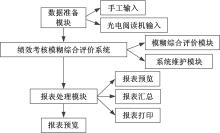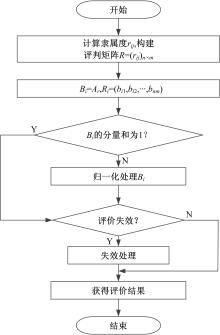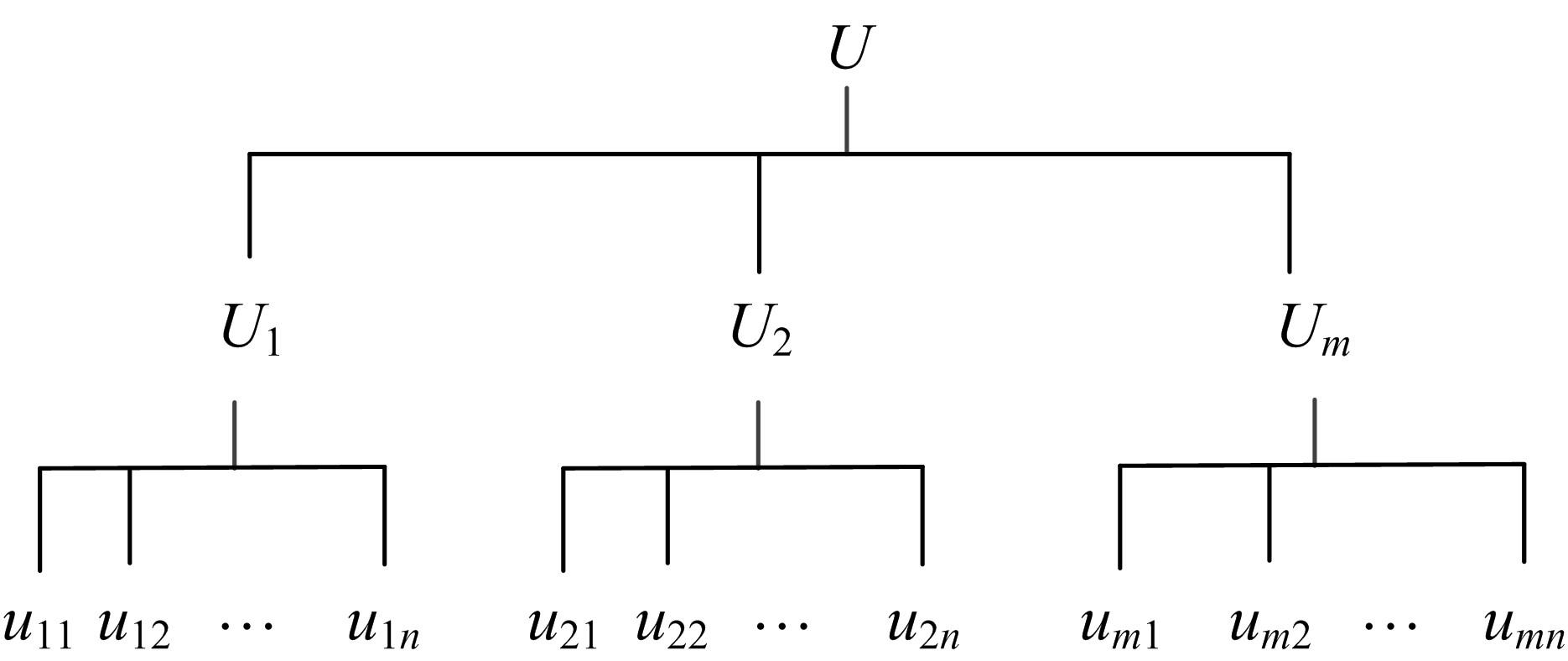吉林大学学报(工学版) ›› 2021, Vol. 51 ›› Issue (5): 1851-1856.doi: 10.13229/j.cnki.jdxbgxb20201004
• 计算机科学与技术 • 上一篇
基于K⁃means聚类算法的绩效考核模糊综合评价系统设计
- 1.吉林大学 人力资源处,长春 130012
2.吉林大学 计算机科学与技术学院,长春 130012
Design of fuzzy comprehensive evaluation system for performance appraisal based on K⁃means clustering algorithm
Meng-su ZHANG1( ),Chun-tian LIU1,Xi-jin LI1,Yong-ping HUANG2(
),Chun-tian LIU1,Xi-jin LI1,Yong-ping HUANG2( )
)
- 1.Human Resources Division,Jilin University,Changchun 130012,China
2.College of Computer Science and Technology,Jilin University,Changchun 130012,China
摘要:
针对传统的绩效考核评价方法需要大量的人力和物力统一分配资源,且输入数据的存储方式也不统一,导致评价效率低和评价准确率低的问题,提出一种基于K-means聚类算法的绩效考核模糊综合评价系统设计方法,通过数据准备模块、绩效考核模糊评价模块、报表处理模块、系统维护模块构成绩效考核模糊综合评价系统的整体结构。采用层次分析法对绩效考核评价指标对应的权重进行计算,构建绩效考核模糊评价模型,采用K-means聚类算法对绩效考核模糊综合评价模型进行求解,实现绩效考核的评价,完成绩效考核模糊综合评价系统的设计。实验结果表明:本文方法的评价效率高、评价准确率高。
中图分类号:
- TP18
| 1 | 宋晨霞, 张海光, 胡庆夕. 高校示范中心全方位绩效考核的探索与实践[J]. 实验技术与管理, 2019, 36(7): 197-200. |
| Song Chen-xia, Zhang Hai-guang, Hu Qing-xi. Exploration and practice of all-sided performance evaluation on university demonstration centers[J]. Experimental Technology and Management, 2019, 36(7):197-200. | |
| 2 | 陈丽娟, 陈滨, 刘海霞. 厦门大学图书馆的绩效考核评价体系[J]. 图书馆论坛, 2020, 40(1): 146-152. |
| Chen Li-juan, Chen Bin, Liu Hai-xia. The performance appraisal system of Xiamen University Library[J]. Library Tribune, 2020, 40(1): 146-152. | |
| 3 | Deng X, Gu Y, Li F, et al. Evaluation of teaching quality of computing method course based on improved BP neural network[J]. Journal of Physics Conference Series, 2021, 1774: 012026. |
| 4 | 李锋, 林华. 基于功效系数法与模糊综合评价法的企业营销绩效考核研究[J]. 学术论坛, 2010, 33(2): 113-116. |
| Li Feng, Lin Hua. Research on enterprise marketing performance evaluation based on efficiency coefficient method and fuzzy comprehensive evaluation method [J]. Academic Forum, 2010, 33(2): 113-116. | |
| 5 | 李桂英. 基于模糊综合评判授课质量评价系统的设计与实现[J]. 华南师范大学学报: 自然科学版, 2003(4): 48-53. |
| Li Gui-ying. Research and design of teaching quality evaluation system based on fuzzy comprehensive evaluation[J]. Joutnal of South China Normal University (Natural Science Edition), 2003(4): 48-53. | |
| 6 | Zhao Y. Research on the application of university teaching management evaluation system based on Apriori algorithm[J]. Journal of Physics, 2021, 1883: 012033. |
| 7 | 李晓霞. 基于模糊综合评价模型的教学评价系统的设计与实现[D]. 成都: 电子科技大学计算机科学与工程学院, 2015. |
| Li Xiao-xia. Design and implementation of teaching evaluation system on fuzzy evaluation[D]. Chengdu: School of Computer Science and Engineering, University of Electronic Science and Technology of China, 2015. | |
| 8 | 杨洁, 黄梦亿, 陈佳. 多粒度邻域粗糙模糊集及其不确定性度量[J]. 重庆邮电大学学报:自然科学版, 2020, 32(5): 898-908. |
| Yang Jie, Huang Meng-yi, Chen Jia. Neighborhood-based multi-granulation rough fuzzy sets and their uncertainty measure[J]. Journal of Chongqing University of Posts and Telecommunications (Natural Science Edition), 2020, 32(5): 898-908. | |
| 9 | 张波, 周从华, 张付全, 等. 一种面向SNP选择的模糊聚类算法[J]. 计算机工程, 2019, 45(8): 66-74. |
| Zhang Bo, Zhou Cong-hua, Zhang Fu-quan,et al. A Fuzzy Clustering Algorithm for SNP Selection[J]. Computer Engineering, 2019, 45(8): 66-74. | |
| 10 | 祖志文, 李秦. 基于粒子群优化的马氏距离模糊聚类算法[J]. 重庆邮电大学学报:自然科学版,2019, 31(2): 279-384. |
| Zu Zhi-wen and Li Qin. Mahalanobis distance fuzzy clustering algorithm based on particle-swarmoptimization[J]. Journal of Chongqing University of Posts and Telecommunications(Natural Science Edition),2019, 31(2): 279-384. | |
| 11 | 钱雪忠,姚琳燕. 面向稀疏高维大数据的扩展增量模糊聚类算法[J]. 计算机工程, 2019, 45(6): 75-81. |
| Qian Xue-zhong,Yao Lin-ya. Extended incremental fuzzy clustering algorithm for sparse high-dimensional big data[J]. Computer Engineering, 2019, 45(6): 75-81. | |
| 12 | 丁志成, 葛洪伟, 周竞. 基于KL散度的密度峰值聚类算法[J]. 重庆邮电大学学报:自然科学版,2019, 31(3): 367-374. |
| Ding Zhi-cheng, Ge Hong-wei,Zhou Jing. Density peaks clustering based on Kullback Leibler divergence[J]. Journal of Chongqing University of Posts and Telecommunications(Natural Science Edition), 2019, 31(3): 367-374. | |
| 13 | 徐勇, 张慧, 陈亮. 一种基于情感分析的UGC模糊综合评价方法——以淘宝商品文本评论UGC为例[J]. 情报理论与实践, 2016, 39(6): 64-69. |
| Xu Yong, Zhang Hui, Chen Liang. A UGC fuzzy comprehensive evaluation method based on sentiment analysis—taking UGC of Taobao Product text reviews[J]. Information Studies: Theory & Application, 2016, 39(6): 64-69. | |
| 14 | 王茜竹, 徐瑞, 江德潮, 雒江涛. 基于多源数据的出行安全时空评价模型研究[J]. 重庆邮电大学学报:自然科学版, 2019, 31(5): 618-627. |
| Jiang De-chao, Luo Jiang-tao. Research on the spatial-temporal evaluation model of travel safety based on multi-source data[J]. Journal of Chongqing University of Posts and Telecommunications (Natural Science Edition), 2019, 31(5): 618-627. | |
| 15 | MacQueen J. Some methods for classification and analysis of multivariate observations[J]. Proceedings of the Fifth Berkeley Symposium on Mathematical Statistics and Probability, 1967, 14(1): 281-297. |
| [1] | 曹洁,屈雪,李晓旭. 基于滑动特征向量的小样本图像分类方法[J]. 吉林大学学报(工学版), 2021, 51(5): 1785-1791. |
| [2] | 姚引娣,贺军瑾,李杨莉,谢荡远,李英. 自构建改进型鲸鱼优化BP神经网络的ET0模拟计算[J]. 吉林大学学报(工学版), 2021, 51(5): 1798-1807. |
| [3] | 赵宏伟,张子健,李蛟,张媛,胡黄水,臧雪柏. 基于查询树的双向分段防碰撞算法[J]. 吉林大学学报(工学版), 2021, 51(5): 1830-1837. |
| [4] | 王春波,底晓强. 基于标签分类的云数据完整性验证审计方案[J]. 吉林大学学报(工学版), 2021, 51(4): 1364-1369. |
| [5] | 欧阳丹彤,刘扬,刘杰. 故障响应指导下基于测试集的故障诊断方法[J]. 吉林大学学报(工学版), 2021, 51(3): 1017-1025. |
| [6] | 钱榕,张茹,张克君,金鑫,葛诗靓,江晟. 融合全局和局部特征的胶囊图神经网络[J]. 吉林大学学报(工学版), 2021, 51(3): 1048-1054. |
| [7] | 朱小龙,谢忠. 基于机器学习的地理空间数据抽取算法[J]. 吉林大学学报(工学版), 2021, 51(3): 1011-1016. |
| [8] | 孙宝凤,任欣欣,郑再思,李国一. 考虑工人负荷的多目标流水车间优化调度[J]. 吉林大学学报(工学版), 2021, 51(3): 900-909. |
| [9] | 王淑敏,陈伟. 基于连续密度隐马尔可夫模型的矿下异常行为识别算法[J]. 吉林大学学报(工学版), 2021, 51(3): 1067-1072. |
| [10] | 刘元宁,吴迪,朱晓冬,张齐贤,李双双,郭书君,王超. 基于YOLOv3改进的用户界面组件检测算法[J]. 吉林大学学报(工学版), 2021, 51(3): 1026-1033. |
| [11] | 陈广秋,陈昱存,李佳悦,刘广文. 基于DNST和卷积稀疏表示的红外与可见光图像融合[J]. 吉林大学学报(工学版), 2021, 51(3): 996-1010. |
| [12] | 沈淑涛,尼玛扎西. 基于区块链技术的双混沌可识篡改图像加密方法[J]. 吉林大学学报(工学版), 2021, 51(3): 1055-1059. |
| [13] | 周炳海,何朝旭. 基于静态半成套策略的多目标准时化物料配送调度[J]. 吉林大学学报(工学版), 2021, 51(3): 910-916. |
| [14] | 顾天奇,胡晨捷,涂毅,林述温. 基于移动最小二乘法的稳健重构方法[J]. 吉林大学学报(工学版), 2021, 51(2): 685-691. |
| [15] | 许骞艺,秦贵和,孙铭会,孟诚训. 基于改进的ResNeSt驾驶员头部状态分类算法[J]. 吉林大学学报(工学版), 2021, 51(2): 704-711. |
|
||





